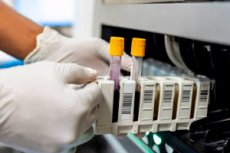Nye publikasjoner
Ny blodprøve for påvisning av hjerneslag kombinerer biomarkører med klinisk vurdering
Sist anmeldt: 02.07.2025

Alt iLive-innhold blir gjennomgått med medisin eller faktisk kontrollert for å sikre så mye faktuell nøyaktighet som mulig.
Vi har strenge retningslinjer for innkjøp og kun kobling til anerkjente medieområder, akademiske forskningsinstitusjoner og, når det er mulig, medisinsk peer-evaluerte studier. Merk at tallene i parenteser ([1], [2], etc.) er klikkbare koblinger til disse studiene.
Hvis du føler at noe av innholdet vårt er unøyaktig, utdatert eller ellers tvilsomt, velg det og trykk Ctrl + Enter.

Hjerneslag er den ledende årsaken til uførhet og den nest ledende dødsårsaken på verdensbasis, men rettidig intervensjon kan forhindre alvorlige konsekvenser. En ny studie av forskere ved Brigham and Women's Hospital og kolleger beskriver utviklingen av en ny test som kombinerer blodbiomarkører med klinisk vurdering for å nøyaktig identifisere pasienter som opplever slag med okklusjon av store kar (LVO).
Resultatene er publisert i tidsskriftet Stroke: Vascular and Interventional Neurology.
«Vi har utviklet et revolusjonerende, tilgjengelig verktøy som kan bidra til å sikre at flere som lider av hjerneslag er på rett sted til rett tid for å motta kritisk, livreddende behandling», sa hovedforfatter Joshua Burnstock, MD, Ph.D., MPH, klinisk fellow ved avdeling for nevrologisk kirurgi ved Brigham and Women's Hospital.
De fleste slag er iskemiske, der blodstrømmen til hjernen blokkeres. LVO-slag er en aggressiv type iskemisk hjerneslag som oppstår når det oppstår en blokkering i en større arterie i hjernen. Når blodtilførselen til hjernen kuttes, fører mangel på oksygen og næringsstoffer til at hjerneceller dør i løpet av minutter. LVO-slag er alvorlige medisinske nødsituasjoner og krever øyeblikkelig behandling ved hjelp av mekanisk trombektomi, en kirurgisk prosedyre som fjerner blokkeringen.
«Mekanisk trombektomi har gjort det mulig for personer som ellers ville dødd eller blitt betydelig ufør, å bli helt friske, som om hjerneslaget aldri hadde skjedd», sa Burnstock. «Jo tidligere denne intervensjonen utføres, desto bedre blir resultatet for pasienten. Denne spennende nye teknologien har potensial til å gjøre det mulig for flere mennesker rundt om i verden å motta denne behandlingen raskere.»
Tidligere har forskerteamet rettet seg mot to spesifikke proteiner som finnes i kapillærblod: ett kalt glial fibrillary acidic protein (GFAP), som også er assosiert med hjerneblødninger og traumatisk hjerneskade; og et annet kalt D-dimer.
I denne studien viste de at blodnivåene av disse biomarkørene, kombinert med FAST-ED-vurderingen for triage av hjerneslag på stedet, kunne identifisere iskemiske hjerneslag i venstresidige kanaler (LVO) samtidig som andre tilstander som hjerneblødninger utelukkes. Blødninger forårsaker lignende symptomer som LVO-slag, noe som gjør dem vanskelige å skille mellom i felten, selv om behandlingen for hver av dem er betydelig forskjellig.
I denne prospektive observasjonsstudien av diagnostisk nøyaktighet undersøkte forskerne data fra en kohort på 323 pasienter innlagt med en hjerneslagkode i Florida mellom mai 2021 og august 2022. De fant at kombinasjonen av GFAP- og D-dimer-biomarkørnivåer med FAST-ED-data mindre enn seks timer fra symptomdebut tillot testen å oppdage LVO-slag med 93 % spesifisitet og 81 % sensitivitet. Andre funn inkluderte at testen ekskluderte alle pasienter med intracerebrale blødninger, noe som signaliserte at teknologien også kunne brukes til å oppdage intracerebrale blødninger i felten.
Burnstocks team ser også lovende fremtidig bruk av dette rimelige diagnostiske verktøyet i lav- og mellominntektsland, der avansert bildediagnostikk ikke alltid er tilgjengelig. Det kan også være nyttig for å vurdere pasienter med traumatisk hjerneskade. De gjennomfører deretter en annen prospektiv studie for å måle testens effektivitet når den brukes i ambulansen. De har også utviklet en intervensjonsstudie som bruker teknologien til å fremskynde triage av slagpasienter, slik at de kan omgå standard bildediagnostikk og gå direkte til intervensjon.
«I behandling av hjerneslag er tid penger», sa Burnstock. «Jo raskere en pasient kommer på riktig behandlingsvei, desto bedre er resultatet. Enten det betyr å utelukke en blødning eller bekrefte at noe trenger intervensjon, vil det å kunne gjøre det i prehospitale omgivelser med teknologien vi har utviklet være virkelig transformerende.»
